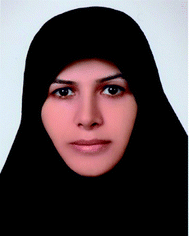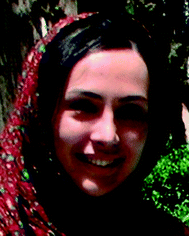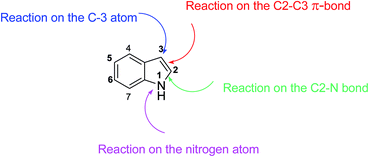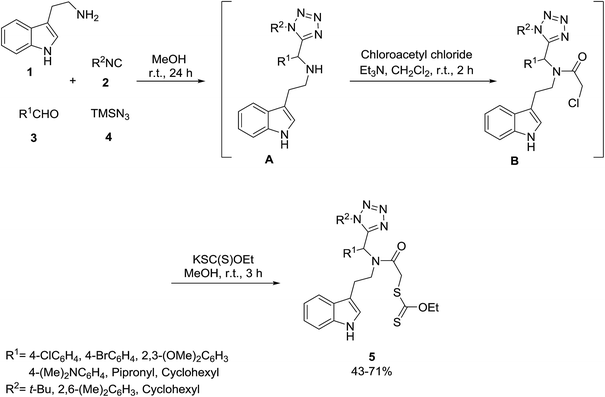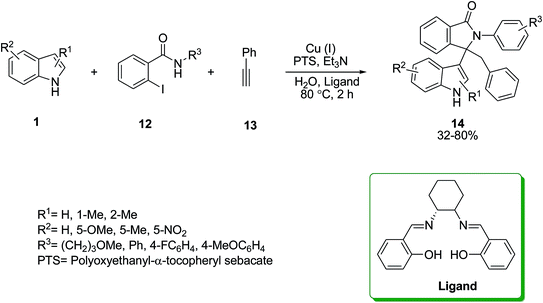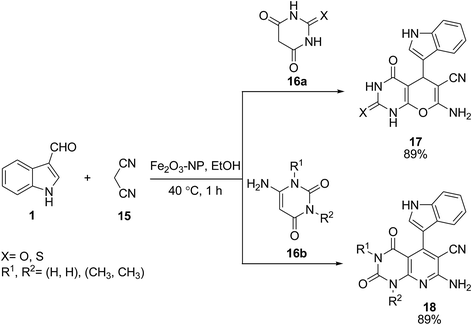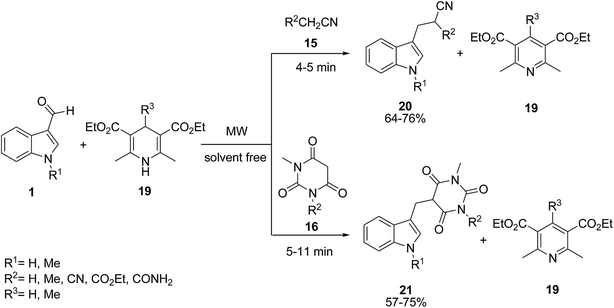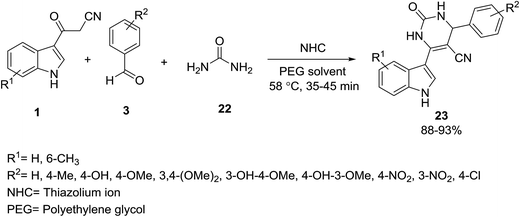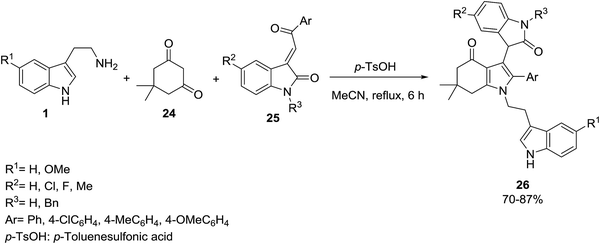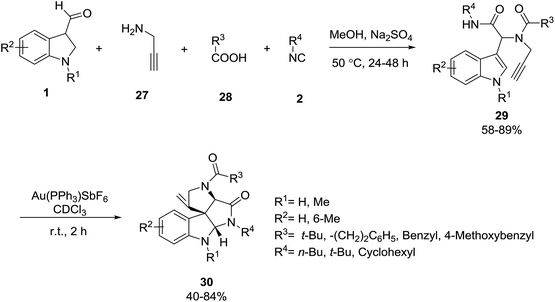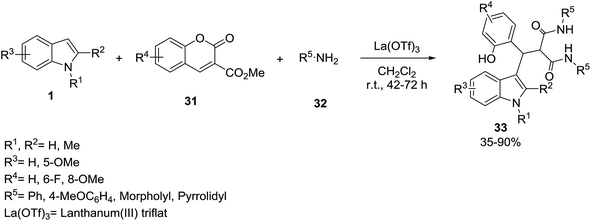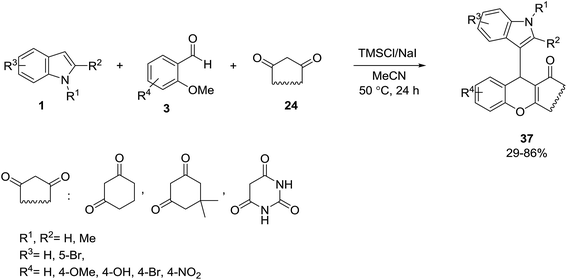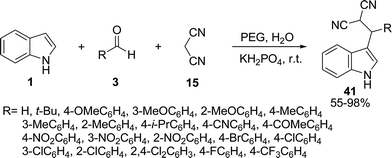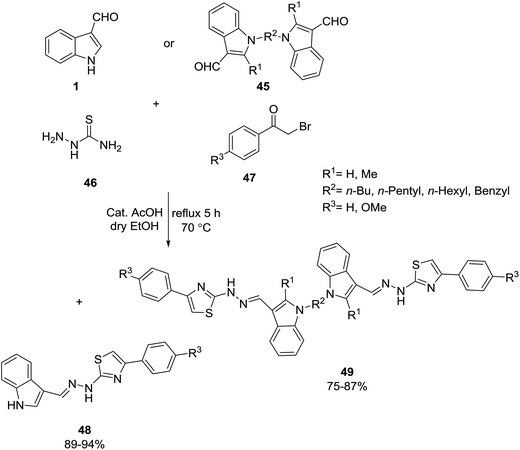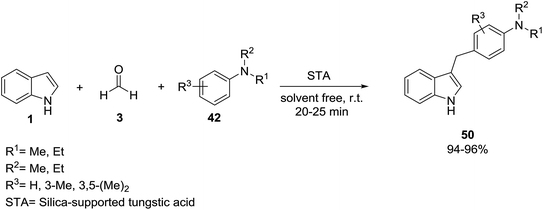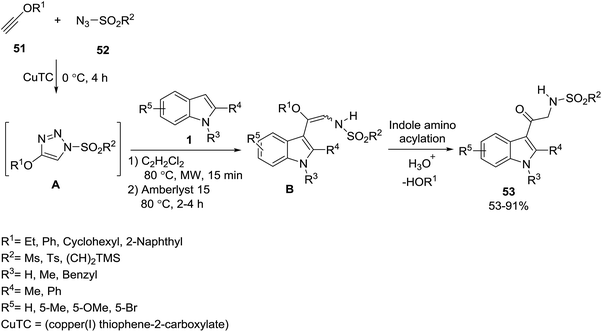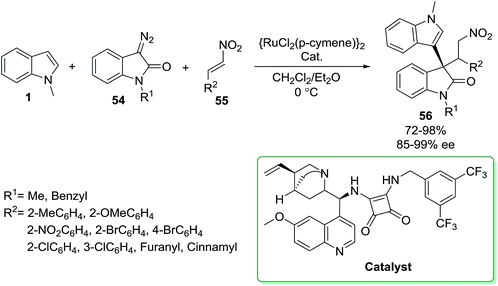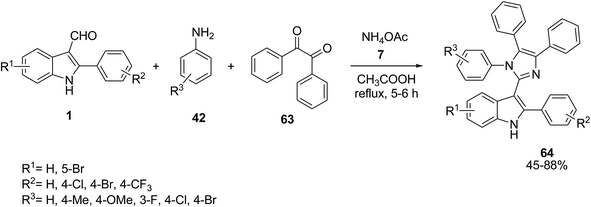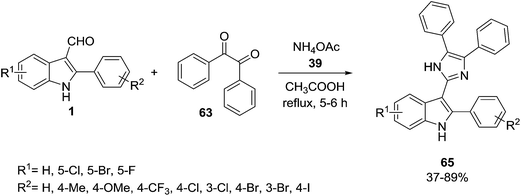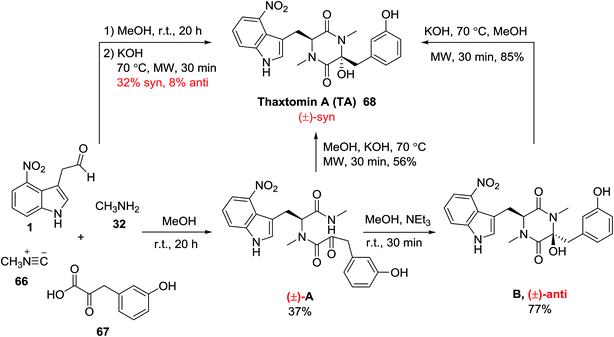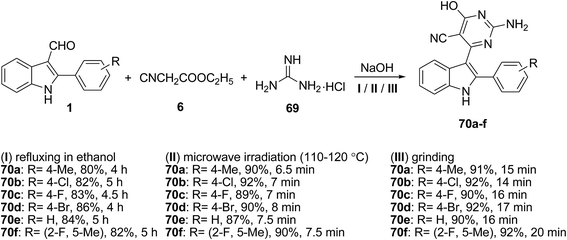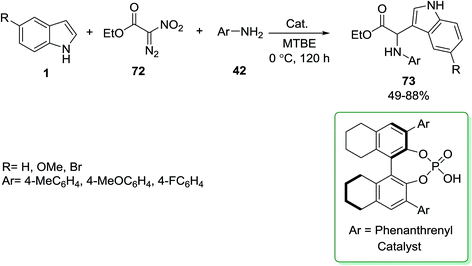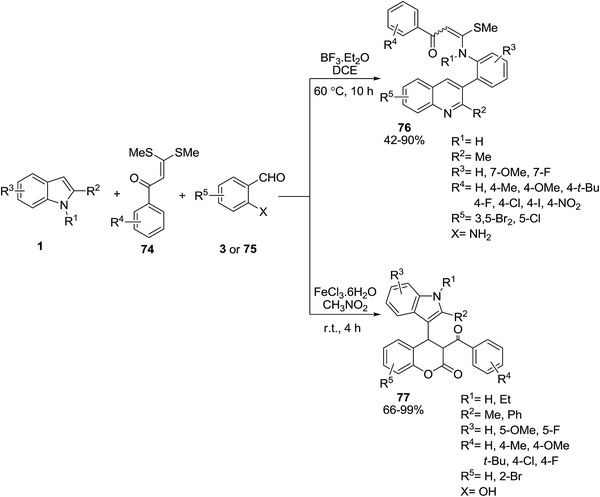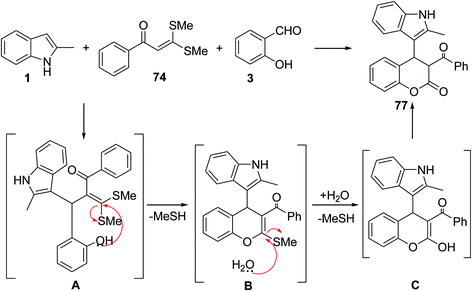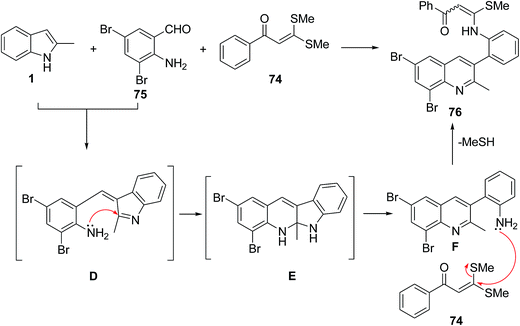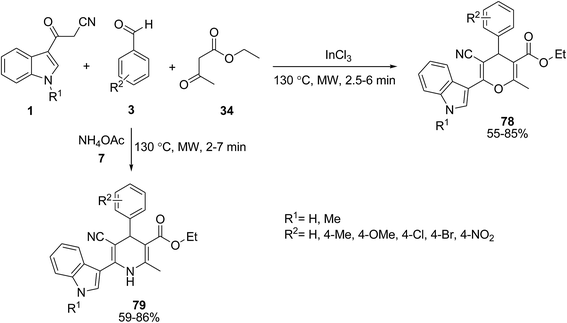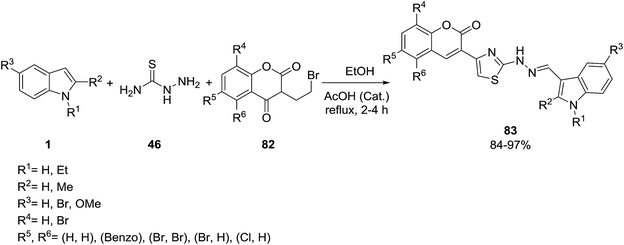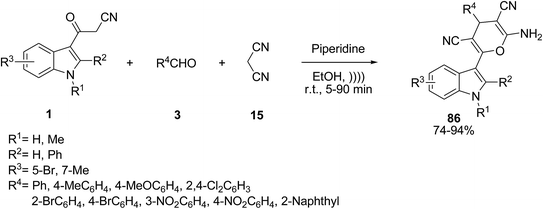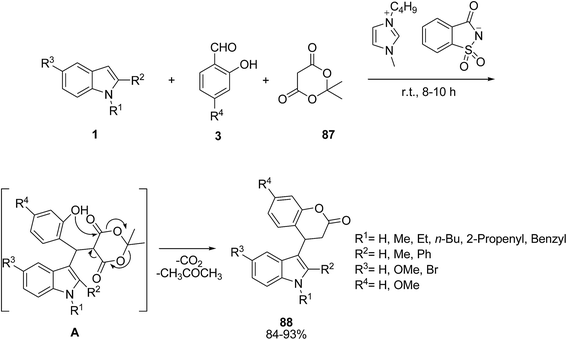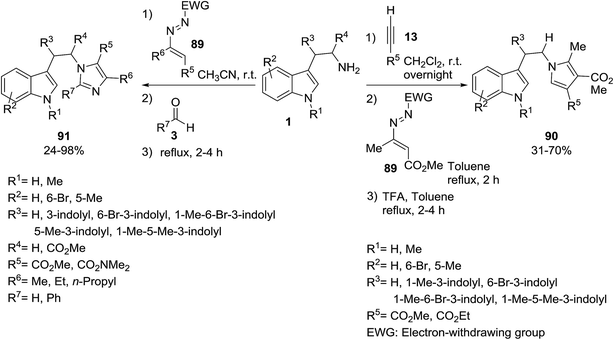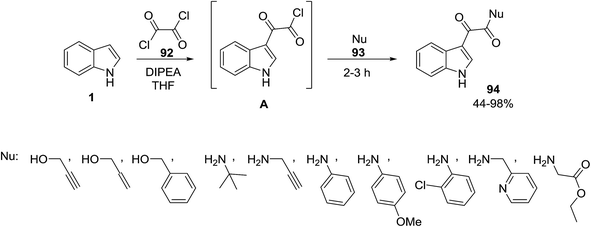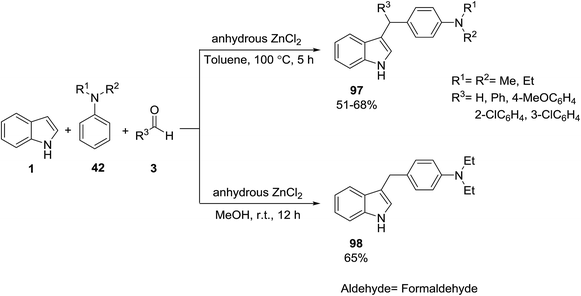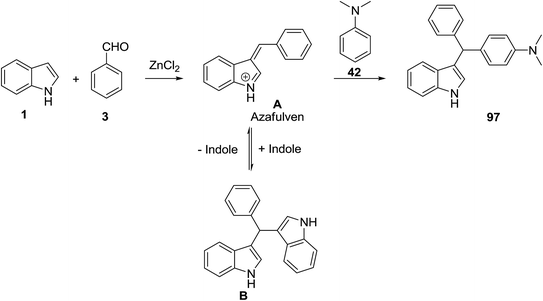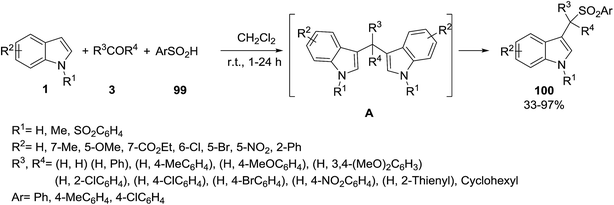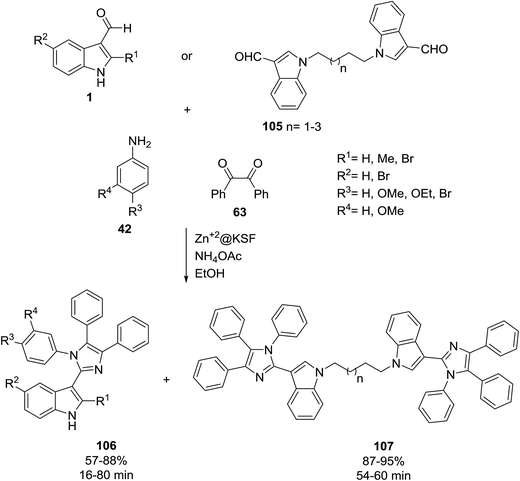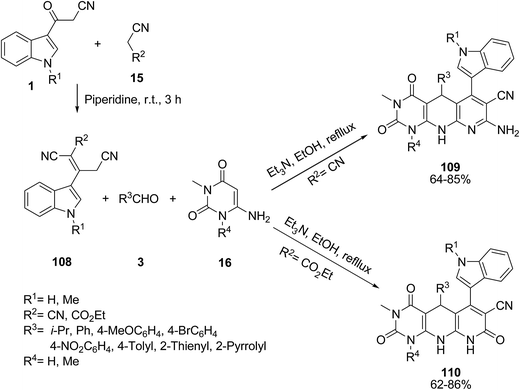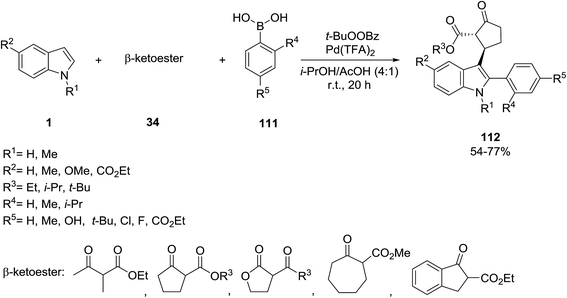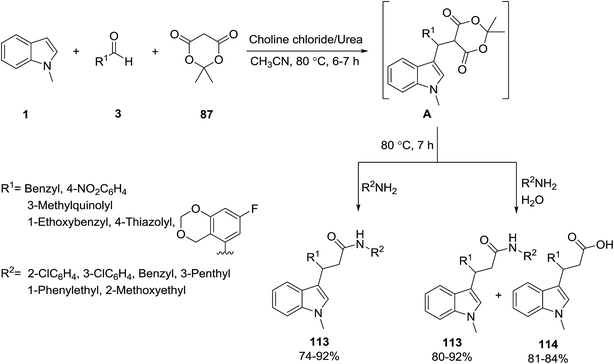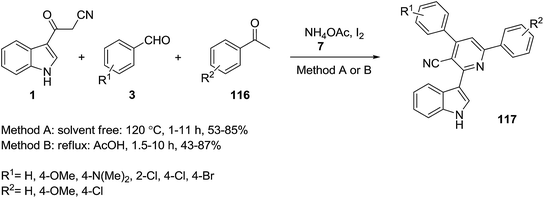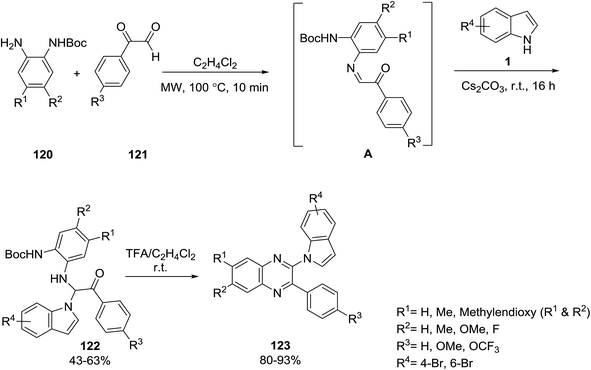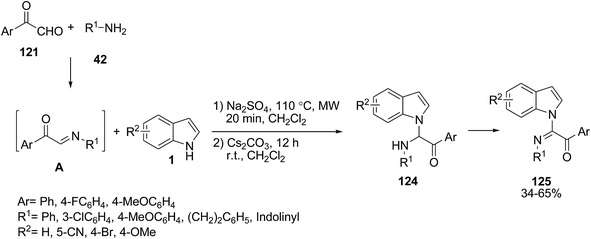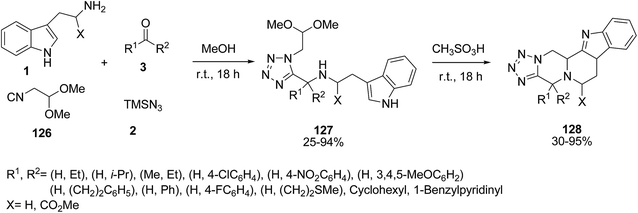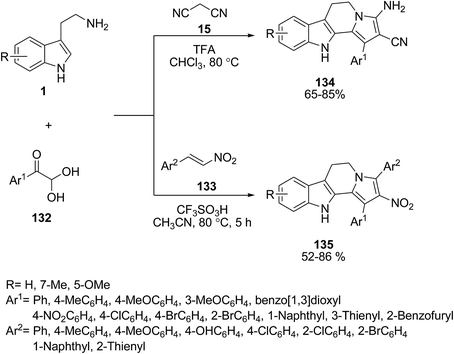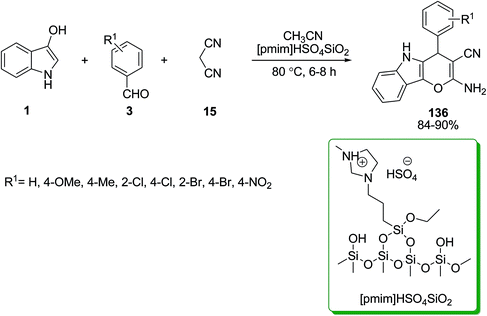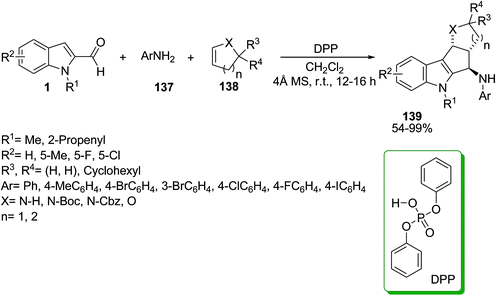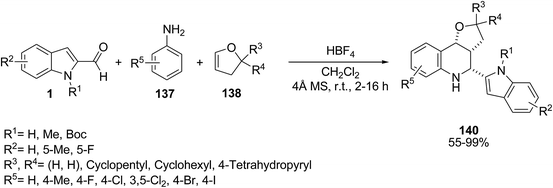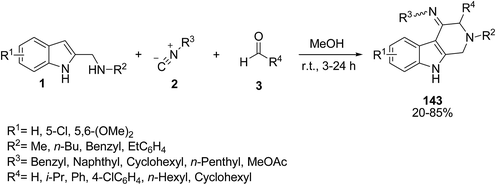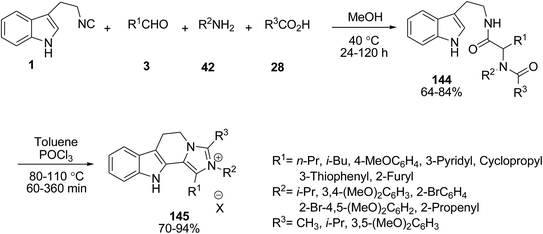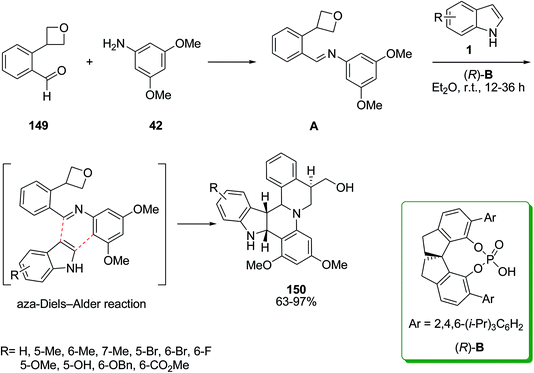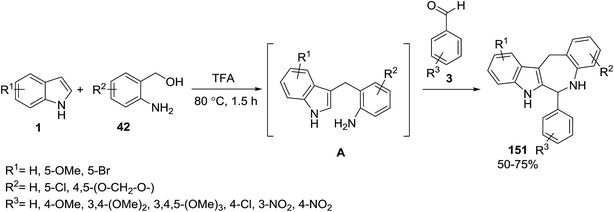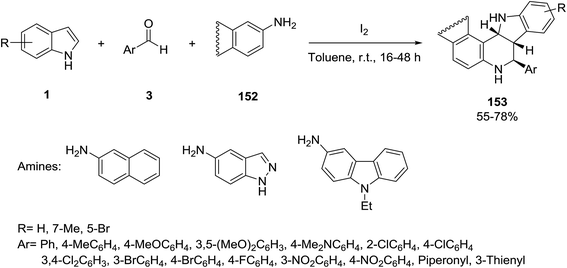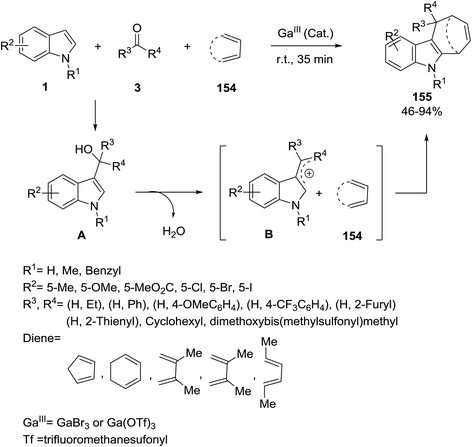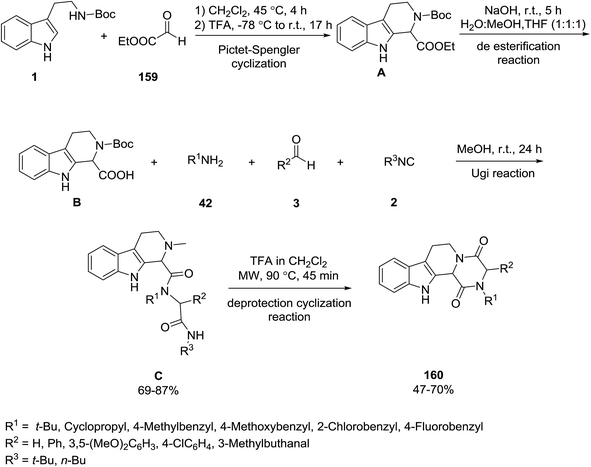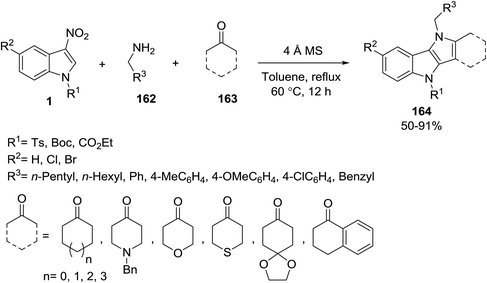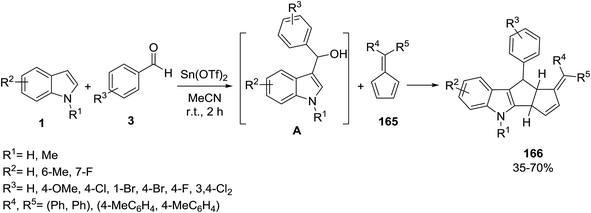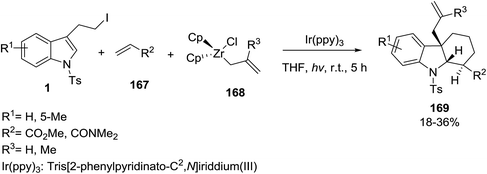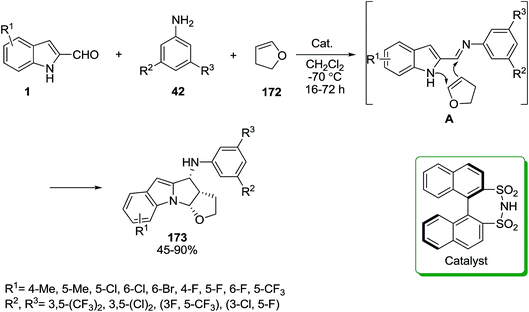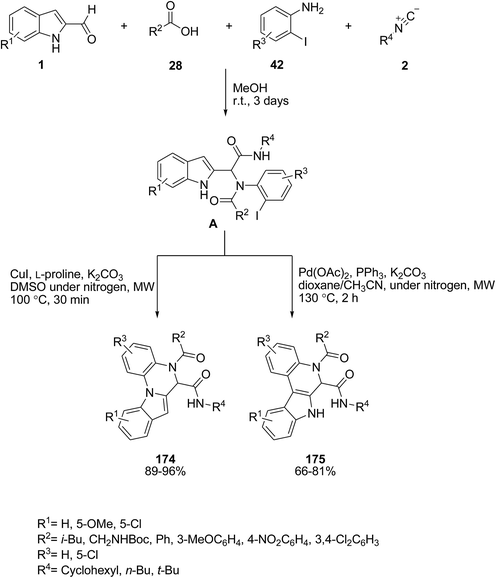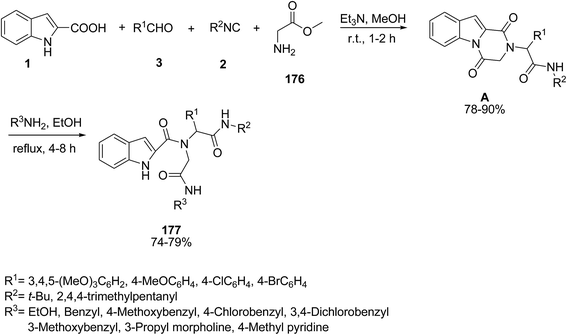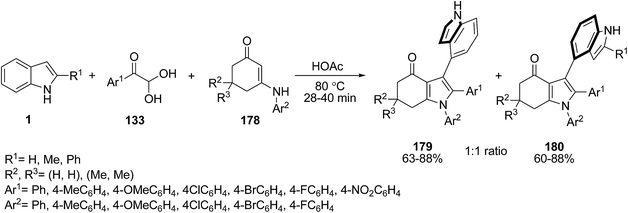 Open Access Article
Open Access ArticleCreative Commons Attribution 3.0 Unported Licence
Recent advances in the application of indoles in multicomponent reactions
Ghodsi Mohammadi Ziarani
 *,
Razieh Moradi
*,
Razieh Moradi
 ,
Tahereh Ahmadi
and
Negar Lashgari
,
Tahereh Ahmadi
and
Negar Lashgari

Department of Chemistry, Alzahra University, Tehran, Iran. E-mail: gmziarani@hotmail.com; gmohammadi@alzahra.ac.ir; Fax: +98 21 88041344; Tel: +98 21 88041344
First published on 28th March 2018
Abstract
Indoles are some of the most versatile and common nitrogen-based heterocyclic scaffolds and are frequently used in the synthesis of various organic compounds. Indole based compounds are very important among heterocyclic structures due to their biological and pharmaceutical activities. The last decade, in particular, has witnessed considerable activity towards the synthesis of indole derivatives due to the possibilities for the design of polycyclic structures by the incorporation of multiple fused heterocyclic scaffolds in an attempt to achieve promising new heterocycles with chemical and biomedical relevance. In this study, we provide an overview on recent applications of indole in the multicomponent reactions for the synthesis of various heterocyclic compounds during the period of 2012 to 2017.
1. Introduction
Heterocyclic compounds are important tools in our daily life having an extensive variety of applications such as sanitizers,1 pharmaceuticals2,3 and antioxidant compounds,4,5 corrosion inhibitors,6,7 dye stuff,8 copolymers,9,10 and as building blocks in the synthesis of organic compounds and natural products. Multicomponent reactions (MCRs) have been extensively used for the synthesis of heterocyclic compounds.11–13 MCRs represent a great tool in organic synthesis for the construction of variety-oriented series of building blocks with potentially interesting biological activities.14–17 The attractiveness of the MCR approach is its easy operation, high selectivity and yield by using minimum synthetic requirements. Indole scaffolds have been known for their value in the development of new compounds of pharmaceutical interest.18–20 Up to date, several review articles have been published based on the reactions of indole.21,22 Herein, in continuation of our studies towards the synthesis of heterocyclic compounds and multicomponent reactions,23–32 and since there is a wide range of reactions that include indole in the preparation of heterocyclic compounds, this review presents the recent applications of indole in the synthesis of diverse heterocyclic compounds during the period from 2012 to 2017. This review first discusses indoles’ C-3 carbon atom reactivity applicable to electrophilic reactions, followed by MCRs in which the N position of indole is reacted as a nucleophile to afford N-substituted indole products. In Section 2.3, indole cycloaddition reactions have been discussed including cycloaddition reactions of the C2–C3 π-bond (Section 2.3.1) and the C–N sigma bond (Section 2.3.2). Finally, in Section 2.4, miscellaneous reactions of indole will be reviewed.2. Multicomponent reactions of indoles
The indole structure is a heterocyclic compound which easily participates in chemical reactions. Its bonding sites are analogous to pyrrole. As shown in Scheme 1, indole is reactive at four different positions including the carbon atom 3, nitrogen atom 1, the C2–C3 π-bond and the C2–N sigma bond. Indole can be protonated with strong acids such as hydrochloric acid, which protonates the C3 position, more easily than the N atom. The cycloaddition reaction is another reaction of indole compounds. The C2–C3 π-bond of indole has a propensity towards cycloaddition reactions but cycloaddition reactions of the C2–N sigma bond are also observed.2.1. The C-3 position reactions of indoles
Gámez-Montaño’s group reported the one-pot Ugi-azide33 multicomponent reaction of indole 1, isocyanides 2, aldehydes 3 and TMSN3 4 (Scheme 2). In the first step, intermediate A was obtained, and then N-acylation was performed between A and chloroacetyl chloride to give the intermediate B, which underwent an SN2 reaction with the potassium ethyl xanthogenate salt to give the final xanthates 5 (Scheme 2).34The one-pot multicomponent reaction of 3-acetylindole 1, aromatic aldehydes 3, ethyl cyanoacetate 6, and ammonium acetate 7 in the presence of piperidine as catalyst was established to access several 6-indolylpyridine-3-carbonitrile derivatives 8 (Scheme 3).35 The anti-proliferative activities of products were evaluated and showed good results.
Indole 1, carbon disulfide 9 and substituted α-bromo propiophenones 10 were reacted via a three component domino [3 + 2] heterocyclization reaction for the preparation of two-carbon-tethered 1,3-oxathiole–indole pair compounds 11 (Scheme 4).36 The results showed that functional groups such as bromide and chloride provide ample opportunity for further functional group manipulations, for example, by modern cross-coupling reactions.
A regioselective Sonogashira37 cyclization reaction was carried out in the presence of CuI as catalyst and 2,2′-(1E,1′E)-(1R,2R)cyclohexane-1,2-diylbis(azan-1-yl-1-ylidene)bis(methan-1-yl-1-ylidene)diphenol as ligand to obtain benzyl-3-(indol-3-yl)-2-phenyl-2,3-dihydroisoindolinones 14. The reaction involved the one-pot multicomponent reaction of indoles 1, 2-iodo-N-phenylbenzamides 12 and terminal alkyne 13 under aerobic conditions followed by a nucleophilic addition (Scheme 5).38
Magnetic nanoparticles (Fe3O4-NPs) catalyzed the synthesis of pyrano[2,3-d]pyrimidines 17 and pyrido[2,3-d]pyrimidines 18. The reactions were performed via the one-pot three component reaction of indole 1, malononitrile 15 and barbituric acids 16a or 6-amino uracil derivatives 16b in EtOH (Scheme 6).39
Baruah et al. presented the synthesis of 3-alkylated indole derivatives 20 and 21 under a microwave-assisted three-component reaction of indole-3-aldehydes 1, alkyl nitriles 15 or barbituric acids 16 with 1,4-dihydropyridine (DHP) derivative 19 (Scheme 7).40 In each case, DHPs are converted to pyridines. In fact, 1,4-dihydropyridine is the reducing agent.
Preparation of a wide variety of new 6-(1H-indol-3-yl)-2-oxo-4-aryl-1,2,3,4 tetrahydropyrimidine-5-carbonitriles 23 was accessed by combining 3-(cyanoacetyl)-indoles 1 with an arylaldehyde 3 and urea 22 in the presence of PEG-400 and a catalytic amount of thiazolium anions (NHCs) (Scheme 8).41
A three-component reaction for the synthesis of functionalized 3-{1-[2-(1H-indol-3-yl)ethyl]-4,5,6,7-tetrahydro-1H-indol-3-yl}indolin-2-ones 26 has been described by Jiang and Yan. The reaction involves a one-pot condensation of indole 1 with dimedone 24 and 3-phenacylideneoxindoles 25 in refluxing acetonitrile with p-toluenesulfonic acid as catalyst (Scheme 9).42
Modha and co-workers provided a novel procedure for the synthesis of diversely substituted spiroindolines 30 via the post-Ugi gold-catalyzed diastereoselective domino cyclization. In this methodology, the Ugi reaction of indole-3-aldehydes 1, propargylamine 27, acids 28 and isocyanides 2 gave the products 29 in good yields which reacted with Au(PPh3)SbF6 in chloroform to produce spiroindolines 30 in moderate yields (Scheme 10).43 In another study, the same group used other amines instead of propargylamine for the synthesis of analogues of these products.44
The indolylmalonamides 33 have been prepared via the three-component reaction of indole derivatives 1, chromene-3-carboxylates 31 and amines 32 in the presence of La(OTf)3 as a Lewis acid catalyst (Scheme 11).45 Indolylmalonamide products 33 showed notable fluorescence activities when they are exposed to long wave UV light (366 nm).
Polyfunctionalized indole derivatives 35 and 36 were generated from the Yonemitsu-type46 trimolecular condensation of indoles 1 with aldehydes 3 and 1,3-dicarbonyl compounds 34, such as malonates and acetoacetates using Lewis acid catalysts under microwave irradiation. The formation of bis-indolic derivative 36 can be easily rationalized in the one pot reaction, where a double addition of indole to the aldehyde is assumed. As already suggested by Gao and Wu,47 the adduct 35 is probably converted into a reactive indolenine derivative A48 by the loss of an active methylene fragment, which reacts with another molecule of indole (Schemes 12 and 13).49 Macroporous copper oxide (mpCuO) was also used as catalyst in this reaction and the same products were isolated in good yields.50 Docking studies against enoyl acyl carrier protein reductase predicted that the compounds bind at the active site with high binding affinity values. In another study, Li et al. used L-proline as catalyst in this reaction.51 The results are summarized in Table 1.
Khalafi-Nezhad et al. developed the use of trimethylsilyl iodide (TMSI) as a multifunctional agent in the one-pot synthesis of 9-(1H-indol-3-yl)xanthen-4-(9H)-ones 37 from the reaction of indoles 1, 2-methoxybenzaldehydes 3 (as O-methyl protected salicylaldehydes) and β-dicarbonyl compounds 24 (Scheme 14).52
The functionalized indole-3-yl pyridines 40 were prepared via an efficient one-pot condensation of cyanoacetylindoles 1, 3-formylchromones 38 and ammonium acetate 7 under stannous chloride 39 mediation in DMF (Scheme 15).53
Wan and co-workers used polyethylene glycol (PEG-200) in a three-component reaction of indoles 1, aldehydes 3, and malononitrile 15 to afford 3-indole derivatives 41 in good to excellent yields (Scheme 16).54 L-Proline,55 tetrabutylammonium fluoride (TBAF),56 Zn-salphen,57 Cu(OAc)2 (ref. 58) and Cu(III)59 were also used as catalysts in this reaction and the results are shown in Table 2.
| Entry | Solvent | Catalyst | Temperature (°C) | Time (h) | Yield (%) |
|---|---|---|---|---|---|
| 1 | H2O | PEG-200 | r.t. | 3 | 55–98 (ref. 54) |
| 2 | EtOH | L-Proline | r.t. | 30–72 | 58–98 (ref. 55) |
| 3 | — | TBAF·3H2O | 60 | 2 | 55–97 (ref. 56) |
| 4 | DCM | Zn-salphen, DIPEA | r.t. | 6 | 13–60 (ref. 57) |
| 5 | PEG-400 | Cu(OAc)2 | 70 | 15–40 | 48–98 (ref. 58) |
| 6 | H2O | Cu(III) | 30 | 12–24 | 70–96 (ref. 59) |
Singh’s group described a highly efficient methodology for the synthesis of 3-amino-alkylated indoles 44 via the one-pot three-component Mannich60 type reaction of amines 42, alcohols 43 and indoles 1. Treatment of amines 42 and alcohols 43 with KOH in toluene in the presence of (Fe(NO3)3·9H2O/TEMPO)61 as catalyst, yielded iminium ion A. Then, the iminium ion A was reacted with indoles 1 to obtain novel 3-substituted indoles 44 (Scheme 17).62 In another study, ferric hydrogen sulfate (FHS)63 was applied as catalyst and the same products were prepared in 87–98%. It was observed that electron-withdrawing groups on the aldehyde reacted rapidly and were better reagents in this reaction. Furthermore, N-methylaniline showed better reactivity in comparison with N-ethylaniline due to the low steric effects. N-Alkylanilines were used in excess to avoid the formation of bis(indolyl)alkanes.64 The reaction was also catalyzed by L-proline,65 Amberlite, IRA-400 Cl resin66 and polyaniline-fluoroboric acid-dodecyl hydrogen sulfate salt (PANI-HBF4).67 Catalyst-free conditions in MeOH have also been reported in 72 h by 28–99% yields.68 A comparison of different catalysts and experimental setups is given in Table 3.
| Entry | Solvent | Catalyst | Temperature (°C) | Time (h) | Yield (%) |
|---|---|---|---|---|---|
| 1 | Toluene | (Fe(NO3)3·9H2O/TEMPO) | r.t. | 32–39 | 79–87 (ref. 62) |
| 2 | — | FHS | 45 | 1–4 | 87–98 (ref. 63) |
| 3 | — | L-Proline | r.t. | 5–18 | 68–89 (ref. 65) |
| 4 | MeOH | IRA-400 Cl resin | r.t. | 1.5–3 | 70–85 (ref. 66) |
| 5 | H2O | PANI-HBF4 | r.t. | 30–50 min | 88–97 (ref. 67) |
| 6 | MeOH | — | 30 | 72 | 28–99 (ref. 68) |
Mahmoodi and co-workers developed the one-pot cyclocondensation of mono- or bis(indole-3-carbaldehyde) 1 or 45,69,70 thiosemicarbazide 46, and phenacyl bromides 47 in the presence of a catalytic amount of AcOH for the preparation of the novel mono- and bis(indol-3-yl)hydrazineyl thiazole derivatives 48 and 49 (Scheme 18).71 The products were evaluated for in vitro antibacterial activity against Gram-positive and Gram-negative bacteria. Some of the products have good antibacterial activity. The product 48 with OCH3 as a donating group exhibited high activity against Gram-positive bacteria.
Shinde and Jeong developed the reaction between indole 1 and formaldehyde 3 with tertiary aromatic amines 42 in the presence of silica-supported tungstic acid (STA) as a heterogeneous acid catalyst under solvent-free conditions. The protocol was performed via the three component Mannich type Friedel–Crafts addition for the preparation of N,N-dialkyl amino arylated indole derivatives 50 (Scheme 19).72 Application of sodium dodecyl sulfate (SDS) as surfactant in this reaction was also reported by Kumar et al. resulting in 78–94% yields of products.73
Mild aminoacylation of indoles 1 through a multicomponent process with ynol ethers 51 and sulfonyl azides 52 was established by Alford and Davies for the synthesis of oxo-tryptamines 53 (Scheme 20).74 First, 4-alkoxy N-sulfonyltriazoles A75 were generated from ynol ethers 51 and sulfonyl azides 52, and treated with indoles 1. Then, the obtained enol ethers B were converted to the amino ketones 53 for the α-aminoacylation of enols.76
N-Methyl indole 1 was reacted with diazooxindole 54 and nitrostyrene 55 in the presence of [Ru] and squaramide as catalysts via an asymmetric Michael addition77 for the synthesis of 3,3′-bis(indole) derivatives 56 (Scheme 21).78
Novel spirooxindole-pyrrolidine compounds 61 and 62 were obtained through 1,3-dipolar cycloaddition of azomethine ylides generated from isatin 57 and sarcosine 59 or thioproline 60 with the dipolarophile 3-(1H-imidazol-2-yl)-2-(1H-indole-3-carbonyl)acrylonitrile 58 (Scheme 22).79 Anticancer activity studies were carried out for the synthesized compounds against A549 lung adenocarcinoma cancer cell line.80 Several of the products showed very high activity against the cancer cell line. Reddy and co-workers also studied this reaction in MeOH as solvent under reflux conditions in 2–3 h giving 80–93% yields. The antimicrobial activity of all products were evaluated against several bacteria and fungi, and showed good activity.81
A one-pot four-component condensation strategy was employed by Naureen’s group for the discovery of indole-based tetra-arylimidazoles 64. This method involves the reaction of 2-arylindole-3-carbaldehydes 1, substituted anilines 42, benzil 63 and ammonium acetate 7 in acetic acid (Scheme 23).82 The anti-urease activity of the synthesized compounds was evaluated and showed good results.
The same authors synthesized several new trisubstituted imidazoles, 3-(4,5-diaryl-1H-imidazol-2-yl)-2-phenyl-1H-indoles 65, via the condensation of substituted indole aldehydes 1, benzil 63 and ammonium acetate 7 in refluxing acetic acid (Scheme 24).83 The products were evaluated for their α-glucosidase inhibition and showed significant α-glucosidase inhibitory activity.
Andreana and his group utilized the one-pot reaction of 4-nitroindolylacetaldehyde 1, methylamine 32, methyl isocyanide 66 and 3-hydroxyphenylpyruvic acid 67 for the synthesis of (±)-thaxtomin A (TA) 68 as a herbicidal natural product. First, the prerequisite dipeptide A was isolated which through a base-mediated keto-amide cyclization reaction afforded two diastereomeric compounds B. Then, compound B was treated with KOH under microwave irradiation to provide the intended product 68 (Scheme 25).84 This natural product was synthesized previously by Zhang et al. and has been demonstrated to possess activity against the tobacco mosaic virus.85
A one-pot three-component reaction of indole-3-aldehyde derivatives 1, ethyl cyanoacetate 6, and guanidine hydrochloride 69 under three different conditions, including microwave irradiation, grindstone technology and reflux, was developed to afford 2-amino-5-cyano-4-[(2-aryl)-1H-indol-3-yl]-6-hydroxypyrimidines 70 (Scheme 26)86 The products 70 were evaluated for their antimicrobial activity against nine pathogenic bacteria and showed mild to moderate activity.
Bhattacharjee et al. employed ammonium chloride (NH4Cl) as catalyst for the preparation of 9-(1H-indol-3-yl)-3,3-dimethyl-2,3,4,9-tetrahydro-1H-xanthen-1-one 71 via the one-pot three-component reaction of indole 1 with salicylaldehyde 3 and dimedone 24 (Scheme 27).87 In another study, Ganguly et al. developed this reaction in the presence of L-proline as catalyst in H2O for 2 h in 86–96% yield.88
So and Mattson reported on the synthesis of glycine products 73 in the presence of chiral BINOL-based phosphoric-acid as catalyst. The process involves the multicomponent coupling reactions of indole derivatives 1, nitrodiazoester 72 and anilines 42 in methyl t-butyl ether (MTBE) as solvent (Scheme 28).89
The three-component reaction of indoles 1, α-oxoketene dithioacetals 74, and aldehyde 3 or 75 was investigated for the synthesis of dihydrocoumarins 76 and quinolines 77 (Scheme 29).90 The reaction mechanism was presented in Scheme 30. The electrophilic reaction of aldehyde 3 with two nucleophiles 1 and 74 resulted in the formation of intermediate A which was converted into a chromene-type intermediate B through an intramolecular substitution.91 Finally, hydrolysis of intermediate B formed 77. The reaction mechanism of aldehyde 75 is shown in Scheme 31. First, the condensation of 75 and indoles 1 produced the intermediate D. The NH2 group of 75 attacked the C2 position of the indole ring, and formed the intermediate E. Cleavage of an endocyclic C–N bond allowed the formation of a quinoline derivative F.91 Then, compound 74 reacted with NH2 group of quinoline F and final product 76 was obtained.
Borah et al. investigated the one-pot multicomponent reaction of 3-(cyanoacetyl)-indoles 1, aromatic aldehydes 3 and ethyl acetoacetate 34 in the presence of InCl3 under microwave irradiation to produce the functionalized 3-(pyranyl)-indole derivatives 78. When ammonium acetate 7 was used as the source of ammonia in this reaction, the one-pot four-component reaction was carried out and 3-(dihydropyridinyl)-indole derivatives 79 were obtained (Scheme 32).92 The results show that electron donating groups (EDG) in the aldehyde increase the product yield, whereas electron withdrawing groups (EWG) decrease the yield of products.
A sulfone-containing Brønsted acid ionic liquid was used in a one-pot reaction of indole 1, salicylaldehydes 3 and 1,1-diphenylethylene 80 for the synthesis of substituted chromane derivatives 81 (Scheme 33).93
A series of indole incorporated thiazolylcoumarins 83 were synthesized from the reaction of indole derivatives 1, thiosemicarbazide 46 and 3-(2-bromoacetyl)-2H-chromen-2-ones94 82 using a catalytic amount of acetic acid (Scheme 34).95 The antibacterial, anticancer and DNA cleavage activities of products were evaluated. The results showed that all products have a good activity towards the screened bacterial strains.
Song et al. established the [3 + 3] cyclization of 3-(cyanoacetyl)-indoles 1 with dialkyl acetylenedicarboxylates (DMAD) 84 and isocyanides 2 for the preparation of 4-H-pyran derivatives 85 containing an indole scaffold (Scheme 35).96
Efficient synthesis of indol-3-yl substituted pyran derivatives 86 was investigated by Ji and co-workers via the one-pot multicomponent reaction of 3-cyanoacetyl indoles 1, aldehydes 3 and malononitrile 15 in the present of piperidine as catalyst under ultrasonic irradiation (Scheme 36).97 Thiamine hydrochloride (vitamin B1) and cetyltrimethylammonium bromide (CTAB) were also utilized as catalysts in this reaction for 25 min giving 92–94% yield.98
A Knoevenagel99 coupling of salicylaldehyde 3 and Meldrum’s acid 87 followed by a Michael type reaction with indole 1 in the presence of a (saccharin)-based functional ionic liquid (imidazolium saccharinate) was reported by Kumar et al. This multicomponent reaction was performed via lactonization decarboxylative elimination to functionalize the C-3 of indoles with dihydrocoumarin to yield indole-3-dihydro-coumarins 88 (Scheme 37).100
Biheterocycles containing indole and azole skeletons 90 and 91 were prepared from the multicomponent reaction of indoles 1, 1,2-diaza-1,3-dienes 89 and aldehydes 3 or alkynes 13 (Scheme 38).101 The synthesized compounds were screened for their in vitro biological studies. The results showed that some of them have anticancer activity against MCF7 and Caco-2 human tumor cell lines.
Stefani and co-workers utilized a mild approach for the synthesis of indole-3-glyoxyl derivatives 94 and indole-3-glyoxyl-1,2,3-triazoles 96. For this purpose, the reaction of indole 1, oxalyl chloride 92 and various nucleophiles 93 was carried out in N,N-diisopropylethylamine (DIPEA) to afford indole-3-glyoxyl derivatives 94 (Scheme 39). On the other hand, indole-3-glyoxyl-1,2,3-triazoles 96 were obtained from the one-pot multicomponent reaction of these reactants and organic azides 95 via click102 chemistry (Scheme 40).103
Indole 1 was reacted with anilines 42 and aldehydes 3 via an anhydrous ZnCl2 catalyzed one-pot three-component reaction to afford diarylmethyl indoles 97 in toluene and 3-arylmethyl indoles 98 in MeOH. The reaction of indole 1 with benzaldehyde 3 in the presence of catalyst formed the azafulven A which reacted with another indole 1 to generate the kinetically stable bis(indolyl)methane B. In the presence of anilines, bis(indolyl)methane converted to the target products 97 (Schemes 41 and 42).104
A series of biologically important 3-(1-arylsulfonylalkyl)indoles 100 were prepared by Huang et al. This process was carried out using a catalyst-free three-component reaction of indoles 1, carbonyl compounds 3, and arenesulfinic acids 99 at room temperature (Scheme 43).105 Bis(indolyl)methanes A were found as the key intermediates in this reaction.
The synthesis of bis(indolyl)methanes 101 was reported by Dhumaskar and Tilve via the reaction of two molecules of indole 1 with aldehydes 3 under solvent-free conditions without any catalyst (Scheme 44).106 Two different methods were employed for this reaction. In method A, the mixture of aldehyde and indole was kept at ambient temperature in a test tube while in method B, the mixture was ground using a mortar and pestle. Method B resulted in the formation of products in shorter reaction times than method A. According to the results, anisaldehyde with an electron donating group at the para position and heptaldehyde failed to react completely. Mohammadi Ziarani and co-workers developed this reaction using the sulfonic acid functionalized silica (SiO2-Pr-SO3H) as catalyst and obtained the same products in short reaction times and good yields (5–20 min and 87–96% yields).107
Mohammadi Ziarani and coworkers synthesized a novel class of symmetrical 3,3-di(indolyl)indolin-2-ones 102 from the reaction of indoles 1 with isatins 57 in the presence of SBA-Pr-SO3H as a solid acid catalyst under mild reaction conditions (Scheme 45).108 The antimicrobial activities of the products were tested and the results demonstrated that the MIC value of one of the products (R1 = R3 = H, R2 = Bn) against B. subtilis was equal to that of chloramphenicol.
Geng’s group developed the one-pot four component reaction of 3-(cyanoacetyl)indoles 1, aromatic aldehydes 3, 1-(9-butylcarbazol-3-yl)ethanone 103 and ammonium acetate 7 for the preparation of several 3-cyano-2-(1H-indol-3-yl)-6-(9-butylcarbazol-3-yl)pyridine derivatives 104. The reaction was performed using AcOH and ethane-1,2-diol (glycol) under microwave irradiation (Scheme 46).109
Zn2+ supported on montmorillonite KSF (Zn2+@KSF) as an efficient heterogeneous catalyst promoted the preparation of mono and bis-indolylimidazole derivatives 106 and 107. This reaction was carried out from the condensation of indole-3-carbaldehyde derivatives 1 or bis-aldehydes 105,110 aniline derivatives 42 and benzil 63 (Scheme 47).111 The antibacterial activity of the synthesized compounds was examined and some of them exhibited promising activities.
Naidu et al. explored the one-pot three-component reaction of 2-cyano-3-(1H-indol-3-yl)-pent-2-enedinitrile or ethyl-2,4-dicyano-3-(1H-indol-3-yl)but-2-enoate derivative 108, aryl aldehydes 3 and 6-aminouracil derivatives 16 (obtained from the reaction of 3-(cyanoacetyl)-indoles 1 and nitrile 14) for the synthesis of some hexahydropyrimido[4,5-b]-1,8-naphthyridine derivatives 109 and 110. It was found that when the indole derivative 108 (R1 = H; R2 = CO2Et) was treated with benzaldehyde (4a) and uracil 16 (R4 = Me) the ester group participated in the cyclization process instead of the nitrile group, and the trioxo-nitrile compound 110 was obtained (Scheme 48).112
The three-component coupling reaction of indoles 1, β-ketoesters 34 and arylboronicacids 111 via the regioselective palladium-catalyzed oxidative reaction was studied for the preparation of indole-based heterocycles 112 (Scheme 49).113 Indole coupled more rapidly than β-ketoester with the arylboronic acid, and this rate variation was important under the three-component reaction conditions, possibly because the coupling with β-ketoester involves an unstable enone intermediate.
Siddalingamurthy et al. described the synthesis of indole-3-propanamide derivatives 113 and 114 via the three-component reaction of N-methyl indole 1, aromatic aldehydes 3 and Meldrum’s acid 87 in the presence of choline chloride/urea ionic liquid as catalyst. At first, Meldrum’s adduct A was generated, which then reacted with various amines, and the indole-3-propanamide derivatives 113 were formed. On the other hand, when Meldrum’s adduct was treated with H2O, corresponding acid products 114 were obtained (Scheme 50).114
A one-pot four-component reaction of 3-(cyanoacetyl)indole 1, benzaldehyde derivatives 3, 3-acetylpyridine 114, and NH4OAc 7 was explored for the preparation of 2-(indol-3-yl)pyridine derivatives 115 (Scheme 51). In the same paper, 4-aryl-2-(1H-indol-3-yl)-6-arylnicotinonitriles 117 were also obtained based on this process, from the reaction of 3-(cyanoacetyl)indole 1, aromatic aldehydes 3, aromatic ketones 116, and NH4OAc 7 under two different conditions (Scheme 52).115
Deb et al. reported a base-promoted three-component one-pot approach for the synthesis of 3-(α,α-diarylmethyl) indoles 119 via arylation of in situ generated 3-indolylalcohols A in an EtOH–H2O solvent system. Substituted indoles 1, benzaldehydes 3 and electron-rich aromatics 118 were used as starting materials in this reaction (Scheme 53).116
2.2. The N position reactions of indoles
Martinez-Ariza et al. reported a two-step one-pot procedure for the synthesis of N-1-quinoxaline-indoles 123 from the reaction of indoles 1, amines 120 and glyoxaldehydes 121. In the first step, α-iminoketones A were formed from the reaction of amines 120 and glyoxaldehydes 121, which were then treated with indole 1 for the preparation of compounds 122. The deprotection-cyclization of 122 was performed for the synthesis of target products 123 (Scheme 54).117Hulme and co-workers reported a one-pot two-step multicomponent reaction of indole 1, arylglyoxaldehyes 121 and amines 42 for the synthesis of α-oxo-acetamidines 125 under microwave conditions. The main reaction step was the N-1 addition of indole to α-iminoketones A (obtained from the reaction of arylglyoxaldehyes 121 and amines 42), followed by an air- or oxygen-mediated oxidation (Scheme 55).118
2.3. The cycloaddition reactions of indoles
Jiang et al. described an aerobic dehydrogenative coupling interaction between indole derivatives 1, diazoacetates 129 and conjugated α-keto esters 130 in the presence of sequential Rh2(OAc)4 and CuCl2 as catalysts for the synthesis of polyfunctional cyclopenta[b]indoles 131 (Scheme 57).121
A acid-catalyzed multicomponent tandem cyclization protocol was applied by Cai et al. for the preparation of polyfunctional dihydroindolizino[8,7-b]indoles 134 and 135. The process involves the reaction of indole derivatives 1, arylglyoxal monohydrates 132 and trans-β-nitrostyrenes 133 or malononitrile 15 under mild, metal-free conditions (Scheme 58).122
The silica supported ionic liquid of [pmim]HSO4SiO2 (silica supported 1-methyl-3-(triethoxysilylpropyl)imidazolium hydrogen sulfate) was used as an efficient catalyst for the synthesis of 2-amino-4,5-dihydro-4-arylpyrano[3,2-b]indole-3-carbonitrile derivatives 136. The reaction was carried out via the three-component condensation of indoles 1, aromatic aldehydes 3 and malononitrile 15 (Scheme 59).123 Other catalysts such as KHPO4 under ultrasonic irradiation124 and triphenylphosphine (PPh3)125 were also used in this reaction as demonstrated in Table 4.
Galvan et al. accomplished the reaction of indole-2-aldehydes 1, imines 137 and alkenes 138 via stereoselective [3 + 2] carbocyclization to achieve cyclopenta[b]indoles 139 or tetrahydroquinolines 140. It was found that the model coupling reaction could be changed to give related products 139 or 140 in the presence of different acid catalysts (Schemes 60 and 61).126
Kundu and co-workers established a new synthetic protocol for the preparation of pyrido- and pyrimido-indoles 141 and 142 employing ethyl 2-amino-1H-indole-3-carboxylates 1, aromatic aldehydes 3, and terminal alkynes 13 in the presence of a Brønsted acid such as trifluoroacetic acid (TFA) (Scheme 62).127 When the reaction catalyzed by Yb(OTf)3 as a Lewis acid, pyrimidoindoles 142 were prepared as the single products in 58–75% yield.
Tron’s group have prepared heteroarylogous 1H-indole-3-carboxamidines 143 utilizing a three-component interrupted Ugi reaction of N-alkyl-N-(1H-indol-2-ylmethyl)amines 1,128 isocyanides 2 and carbonyl compounds 3 (Scheme 63).129
Silvani et al. reported an impressive method to prepare dihydroimidazo[1′,5′:1,2]pyrido[3,4-b]indol-2-ium salts 145 utilizing a Ugi/Bischler-Napieralski/heterocyclization MCR. The Ugi reaction was carried out following a general procedure, consisting of the sequential addition of aldehydes 3, amines 42, acids 28 and, finally, indole 1 for the synthesis of compounds 144. Treatment of intermediate compounds 144 in MeOH under the Bischler–Napieralski and heterocyclization gave the intended products 145 (Scheme 64).130
A gold-catalyzed multicomponent reaction of vinyl indoles 1 with two N-allenamides 146 and 147 was investigated by Pirovano et al. to prepare tetrahydrocarbazole 148 in 78% yield (Scheme 65).131
Chiral phosphoric acid was used as the catalyst in the asymmetric aza-Diels–Alder reaction132 of indole derivatives 1 with 2-azadiene generated in situ from oxetane 149133 and 3,5-dimethoxyaniline 42 to obtain a series of indole-alkaloid-type polycycles 150 (Scheme 66).134 The authors hypothesized that the introduction of a hydrogen-bond acceptor on the aldehyde moiety may help to orient the transition state and lower the activation barrier for the desired process. Thus, they employed substrates with a simple ether group in proximity to the aldehyde moiety, and encouragingly, the desired aza-Diels–Alder reaction proceeded cleanly to form the desired products with good yields and diastereoselectivities. The biological activity evaluation of the products showed that the cytotoxicities of products in human lung carcinoma and human cervical carcinoma cells exhibited inhibitory effects against cell proliferation with IC50 values in the range of 15.0–27.5 μM.
The annulation of indoles 1, 2-amino benzyl alcohols 42 and benzaldehydes 3 in a two step three-component tandem reaction was used to form benzazepinoindoles 151. In the first step, indoles were C-3 alkylated and the intermediates A were obtained. Then in the second step, intermediates A underwent a 7-endo-trig cyclization (the modified Pictet–Spengler cyclization reaction) to obtain the intended products 151 (Scheme 67).135
A stereoselective Povarov reaction136,137 catalyzed by iodine was developed by Wang and co-workers for the preparation of exo-tetrahydroindolo[3,2-c]quinoline derivatives 153. The procedure involved a reaction between indoles 1, aldehydes 3 and amines 152 in toluene (Scheme 68).138 The results showed that only reactive amines could be included in this reaction to give the desired products 153 with high stereoselectivity.
Gallium(III) (GaBr3) catalyzed a three component [4 + 3] cycloaddition reaction of indoles 1, aldehyde/ketone/ketal derivatives 3 and dienes 154 to furnish cyclohepta[b]indoles 155. The authors have proposed the mechanism of formation of the product via nucleophilic addition of the C3 of indole to electrophile 3 to give the alcohol A, which in the presence of a Lewis acid generated the indolyl cation B. The treatment of B with diene component 154 afforded the corresponding products (Scheme 69).139
Damavandi and Sandaroos have synthesized 2,9-dihydro-2-oxo-4-aryl-1H-pyrido[2,3-b]indole-3-carbonitriles 158 by the one-pot multicomponent cyclocondensation reaction of 1-methyl-1H-indol-2-ol 1, substituted (triethoxymethyl) arenes 156 and cyanoacetamide 157 in the presence of silica supported ionic liquid [pmim]HSO4SiO2 as a catalyst (Scheme 70).140
A new series of diketopiperazine-fused tetrahydro-β-carboline ring systems 160 were obtained via the Pictet–Spengler/Ugi-4CR/deprotection-cyclization reactions. According to the proposed mechanism, the Pictet–Spengler cyclization of indole 1 and ethyl glyoxalate 159 followed by a deesterification reaction produced 2,3,4,9-tetrahydro-1H-pyrido[3,4-b]indole-1-carboxylic acid B. The reaction of acid B, amines 42, isocyanides 2 and aldehyde 3 via the Ugi reaction gave the intermediate products C. The deprotection cyclization reaction of this intermediate generated the target products 160 (Scheme 71).141
A stereoselective catalyst-free three-component reaction of 2-isocyanoethylindole 1, malononitrile 15 and aldehyde 3 was developed for the construction of polycyclic spiroindolines 161 in high yields (up to 90%) with excellent levels of diastereoselectivity (Scheme 72).142 The presence of an electron-withdrawing group on the aldehyde led to a decrease in yields of the products.
John and co-workers developed a multicomponent reaction involving N-protected 3-nitroindole 1 a primary amine 162 and an enolizable ketone 163 for the preparation of a series of functionalized pyrrolo[3,2-b]indoles 164 (Scheme 73).143 It was found that the yield of product 164 decreased to 45% with 1-phenylethylamine. With cyclohexylamine, the product 164 was obtained in moderate yield (53%) and with adamantylamine the MCR failed, proving that the reactivity decreases with an increase in the steric bulk of the amine component.
The Lewis acid catalyzed three-component [3 + 2] cycloaddition reaction of pentafulvene 165 with in situ generated indolylmethanol A has been developed for the construction of pentaleno[1,2-b]indoles 166 (Scheme 74).144 It was found that aromatic aldehydes bearing electron-withdrawing groups (R3 = Cl, Br, F) were tolerated well under the reaction conditions and afforded the cycloaddition products in moderate to good yields. However, aldehydes with electron-rich substituents (R3 = 2,4-OMe, Me) were unable to take part in the cycloaddition reaction.
Alpers et al. developed a photoinduced three-component radical [4 + 2]-cyclization–allylation reaction between 3-(2-iodoethyl)indoles 1, acceptor-substituted alkenes 167, and allyl zirconocenes of the structure Cp ZrCl(σ-allyl) 168 for the synthesis of hexahydrocarbazoles 169 (Scheme 75).145
A copper(I)-catalyzed cascade multicomponent reaction strategy was performed for the construction of 5-hydroxy-1H-pyrrol-2(5H)-ones 171 bearing an indole moiety. The reaction was carried out using substituted indole 1, (Z)-3-iodoacrylic acids 170 and terminal alkynes 13 (Scheme 76).146
The Ugi four-component condensation of indole-2-aldehyde derivatives 1, acids 28, anilines 42 and isocyanides 2 in the presence of orthogonal copper and palladium catalysts under microwave heating was accomplished for the synthesis of two important indole-fused heterocycles 174 and 175. First, the Ugi adduct A was obtained via the intramolecular cyclization conditions and served as a precursor in subsequent selective post-transformations. 5,6-Dihydroindolo[1,2-a]quinoxalines 174 were prepared by a copper catalyzed N–H arylation pathway, while 6,7-dihydroindolo[2,3-c]quinolones 175 were formed by palladium catalyzed C–H arylations without the protection of the indole N1 moiety (Scheme 78).148 In another approach to synthesize these compounds, no catalyst has been employed in this reaction and the products were obtained in good yields.149
2.4. Miscellaneous reactions of indoles
Pandey et al. have published their results on the synthesis of diverse indole-2-carboxamides 177 via a two-step multicomponent reactions. Initially, Et3N was added to amino ester hydrochloride 176 and after 10 minutes, 1H-indole-2-carboxylic acid 1, aldehyde 3, and isocyanide 2 were successively added to the mixture to produce corresponding indole-fused diketopiperazines A.150 Then, compound A in the presence of amines formed the functionalized carboxamides 177 (Scheme 79).151 The biological activities of products were evaluated and showed that most products have anti-leishmanial activity against intracellular amastigotes form of Leishmania donovani.Fu and co-workers designed a strategy for the preparation of 3,2′- 179 and 3,3′-bis-indoles 180 through the microwave-assisted regioselective reaction of indoles 1, arylglyoxal monohydrate 133 and diverse N-aryl enaminones 178 in HOAc (Scheme 80).152 The 2-unsubstituted indoles resulted in 3,2′-bis-indole frameworks 179, while indoles bearing a methyl or phenyl group at C2 led to the 3,3′-bis-indoles 180 with simultaneous formation of three sigma-bonds.
3. Conclusion and outlook
This review summarizes recent studies on the application of indoles in multicomponent reactions for the synthesis of a variety of heterocyclic compounds during the period of 2012 to 2017. Indole is a significant nitrogen-based heterocycle with particular importance in the synthesis of complex heterocyclic scaffolds. Indole fragments have been recently attracting much attention due to their biological and pharmaceutical activities. Diversely multisubstituted indole substances are useful building blocks in pharmaceutical and organic syntheses. Consequently, the novel methodologies for the synthesis of complex heterocyclic frameworks involving indole are expected to receive further increasing attention in the future.4. Conflicts of interest
There are no conflicts to declare.5. Abbreviations
| CTAB | Cetyltrimethylammonium bromide |
| DCE | 1,2-Dichloroethylene |
| DIPEA | N,N-Diisopropylethylamine |
| DMAD | Dialkyl acetylenedicarboxylate |
| DMF | Dimethylformamide |
| DPP | Diketopyrrolopyrrole |
| EA | Ethyl acetate |
| FHS | Ferric hydrogen sulfate |
| MTBE | Methyl tert-butyl ether |
| mpCuO | Macroporous copper oxide |
| MW | Microwave |
| NHC | N-Heterocyclic carbene |
| NPs | Nanoparticles |
| PEG | Polyethylene glycol |
| PMDETA | Pentamethyldiethylenetriamine |
| PTS | Polyoxyethanyl-α-tocopheryl sebacate |
| SDS | Sodium dodecyl sulfate |
| STA | Silica-supported tungstic acid |
| TBAF | Tetra-n-butylammonium fluoride |
| TFA | Trifluoroacetic acid |
| THF | Tetrahydrofuran |
6. Acknowledgements
We are grateful for financial support from the Research Council of Alzahra University and support of National Elites Foundation of Iran, Tehran.7. References
- A. Sniady, M. S. Morreale, K. A. Wheeler and R. Dembinski, Eur. J. Org. Chem., 2008, 2008, 3449 CrossRef.
- A. J. Cocuzza, D. R. Chidester, S. Culp, L. Fitzgerald and P. Gilligan, Bioorg. Med. Chem. Lett., 1999, 9, 1063 CrossRef CAS PubMed.
- E. Vitaku, D. T. Smith and J. T. Njardarson, J. Med. Chem., 2014, 57, 10257 CrossRef CAS PubMed.
- P. Vitaglione and V. Fogliano, J. Chromatogr. B, 2004, 802, 189 CrossRef CAS PubMed.
- B. F. Abdel-Wahab, G. E. Awad and F. A. Badria, Eur. J. Med. Chem., 2011, 46, 1505 CrossRef CAS PubMed.
- J. Talati and D. Gandhi, Corros. Sci., 1983, 23, 1315 CrossRef CAS.
- P. B. Raja and M. G. Sethuraman, Mater. Lett., 2008, 62, 113 CrossRef CAS.
- C. Stead, Dyes Pigments, 1982, 3, 161 CrossRef CAS.
- L. Guo and D. Zhang, J. Am. Chem. Soc., 2009, 131, 18072 CrossRef CAS PubMed.
- E. Butuc and G. M. Gherasim, J. Polym. Sci., 1984, 22, 503 CAS.
- J. D. Sunderhaus and S. F. Martin, Chem.–Eur. J., 2009, 15, 1300 CrossRef CAS PubMed.
- J. Zhu, Eur. J. Org. Chem., 2003, 2003, 1133 CrossRef.
- B. Jiang, T. Rajale, W. Wever, S. J. Tu and G. Li, Chem.–Asian J., 2010, 5, 2318 CrossRef CAS PubMed.
- I. Ugi, A. Dömling and B. J. Werner, Heterocycl. Chem., 2000, 37, 647 CrossRef CAS.
- C. O. Kappe, Acc. Chem. Res., 2000, 33, 879 CrossRef CAS PubMed.
- R. V. A. Orru and M. de Greef, Synthesis, 2003, 1471 CrossRef CAS.
- T. Ngouansavanh and J. Zhu, Angew. Chem., 2006, 118, 3575 CrossRef.
- M. Somei and F. Yamada, Nat. Prod. Rep., 2005, 22, 73 RSC.
- A. C. Kinsman and M. A. Kerr, J. Am. Chem. Soc., 2003, 125, 14120 CrossRef CAS PubMed.
- F. J. Chang, J. B. Rangisetty, M. Dukat, V. Setola, T. Raffay, B. Roth and R. A. Glennon, Bioorg. Med. Chem. Lett., 2004, 14, 1961 CrossRef PubMed.
- M. Shiri, M. A. Zolfigol, H. G. Kruger and Z. Tanbakouchian, Chem. Rev., 2009, 110, 2250 CrossRef PubMed.
- M. Shiri, Chem. Rev., 2012, 112, 3508 CrossRef CAS PubMed.
- G. Mohammadi Ziarani and P. Hajiabbasi, Heterocycles, 2013, 87, 1415 CrossRef.
- G. Mohammadi Ziarani, R. Moradi and N. Lashgari, ARKIVOC, 2016, 1, 1 Search PubMed.
- G. Mohammadi Ziarani, R. Moradi and N. Lashgari, Tetrahedron: Asymmetry, 2015, 26, 517 CrossRef CAS.
- G. Mohammadi Ziarani, N. Hosseini Nasab and N. Lashgari, RSC Adv., 2016, 6, 38827 RSC.
- G. Mohammadi Ziarani, F. Aleali and N. Lashgari, RSC Adv., 2016, 6, 50895 RSC.
- G. Mohammadi Ziarani, P. Gholamzadeh, N. Lashgari and P. Hajiabbasi, ARKIVOC, 2013,(i), 470 Search PubMed.
- G. Mohammadi Ziarani, N. Lashgari, F. Azimian, H. G. Kruger and P. Gholamzadeh, ARKIVOC, 2015,(vi), 1 Search PubMed.
- T. Ahmadi, G. Mohammadi Ziarani, P. Gholamzadeh and H. Mollabagher, Tetrahedron: Asymmetry, 2017, 28, 708 CrossRef CAS.
- R. Moradi, G. Mohammadi Ziarani and N. Lashgari, ARKIVOC, 2017,(i), 148 CrossRef CAS.
- M. Rahimifard, G. Mohammadi Ziarani and B. M. Lashkariani, Turk. J. Chem., 2014, 38, 345 CrossRef CAS.
- I. Ugi, R. Meyr, U. Fetzer and C. Steinbrückner, Angew. Chem., 1959, 71, 386 Search PubMed.
- R. E. Gordillo-Cruz, A. Rentería-Gómez, A. Islas-Jácome, C. J. Cortes-García, E. Díaz-Cervantes, J. Robles and R. Gámez-Montaño, Org. Biomol. Chem., 2013, 11, 6470 CAS.
- N. S. El-Sayed, A. N. Shirazi, M. G. El-Meligy, A. K. El-Ziaty, D. Rowley, J. Sun, Z. A. Nagib and K. Parang, Tetrahedron Lett., 2014, 55, 1154 CrossRef CAS PubMed.
- J. Y. Liu, H. Zhang, B. M. Feng, B. Jiang, S. L. Wang and S. J. Tu, Org. Biomol. Chem., 2012, 10, 5036 CAS.
- K. Sonogashira, J. Organomet. Chem., 2002, 653, 46 CrossRef CAS.
- S. Sarkar, R. Pal and A. K. Sen, Tetrahedron Lett., 2013, 54, 4273 CrossRef CAS.
- M. Kidwai, A. Jain and S. Bhardwaj, Mol. Diversity, 2012, 16, 121 CrossRef CAS PubMed.
- B. Baruah, P. S. Naidu, P. Borah and P. J. Bhuyan, Mol. Diversity, 2012, 16, 291 CrossRef CAS PubMed.
- S. Fatma, D. Singh, P. Mishra, P. K. Singh, P. Ankit, M. Singh and J. Singh, RSC Adv., 2013, 3, 22527 RSC.
- Y. H. Jiang and C. G. Yan, Synthesis, 2016, 48, 3057 CrossRef CAS.
- A. Kumar, D. D. Vachhani, S. G. Modha, S. K. Sharma, V. S. Parmar and E. V. Van Der Eycken, Beilstein J. Org. Chem., 2013, 9, 2097 CrossRef PubMed.
- S. G. Modha, A. Kumar, D. D. Vachhani, J. Jacobs, S. K. Sharma, V. S. Parmar, L. Van Meervelt and E. V. Van der Eycken, Angew. Chem., Int. Ed., 2012, 51, 9572 CrossRef CAS PubMed.
- J. J. Jennings, C. P. Bhatt and A. K. Franz, J. Org. Chem., 2016, 81, 6211 CrossRef CAS PubMed.
- J. Inanaga, K. Hirata, H. Saeki, T. Katsuki and M. Yamaguchi, Bull. Chem. Soc. Jpn., 1979, 52, 1989 CrossRef CAS.
- K. Gao and J. Wu, Org. Lett., 2008, 10, 2251 CrossRef CAS PubMed.
- J.-i. Matsuo, Y. Tanaki and H. Ishibashi, Tetrahedron, 2008, 64, 5262 CrossRef CAS.
- A. Viola, L. Ferrazzano, G. Martelli, S. Ancona, L. Gentilucci and A. Tolomelli, Tetrahedron, 2014, 6781 CrossRef CAS.
- G. A. Khan, J. A. War, G. A. Naikoo, U. J. Pandit and R. Das, J. Saudi Chem. Soc., 2016, 22, 6 CrossRef.
- M. Li, A. Taheri, M. Liu, S. Sun and Y. Gu, Adv. Synth. Catal., 2014, 356, 537 CrossRef CAS.
- A. Khalafi-Nezhad, M. Nourisefat and F. Panahi, Synthesis, 2014, 46, 2071 CrossRef CAS.
- N. Poomathi, D. Muralidharan and P. T. Perumal, Tetrahedron Lett., 2013, 54, 7091 CrossRef CAS.
- L. Wang, M. Huang, X. Zhu and Y. Wan, Appl. Catal., A, 2013, 454, 160 CrossRef CAS.
- Y. H. He, J. F. Cao, R. Li, Y. Xiang, D. C. Yang and Z. Guan, Tetrahedron, 2015, 71, 9299 CrossRef CAS.
- N. Singh, B. K. Allam, D. S. Raghuvanshi and K. N. Singh, Adv. Synth. Catal., 2013, 355, 1840 CrossRef CAS.
- D. Anselmo, E. C. Escudero-Adán, M. Martínez Belmonte and A. W. Kleij, Eur. J. Inorg. Chem., 2012, 4694 CrossRef CAS.
- S. Chandrasekhar, V. Patro, G. P. K. Reddy and R. Grée, Tetrahedron Lett., 2012, 53, 6223 CrossRef CAS.
- H. Jiang, L. Wang and J. Xie, J. Chem. Res., 2016, 40, 338 CrossRef CAS.
- C. Mannich and W. Krösche, Arch. Pharm., 1912, 250, 647 CrossRef CAS.
- E. Zhang, H. Tian, S. Xu, X. Yu and Q. Xu, Org. Lett., 2013, 15, 2704 CrossRef CAS PubMed.
- V. K. Singh, L. K. Sharma and R. K. P. Singh, Tetrahedron Lett., 2016, 57, 407 CrossRef CAS.
- H. Eshghi, M. Rahimizadeh, Z. Bakhtiarpoor and M. Pordel, Chin. Chem. Lett., 2012, 23, 673 CrossRef CAS.
- M. Rahimizadeh, H. Eshghi, M. Mokaber-Esfahani and M. Gholizadeh, J. Chin. Chem. Soc., 2014, 61, 1265 CrossRef CAS.
- A. Kumar, M. K. Gupta and M. Kumar, Green Chem., 2012, 14, 290 RSC.
- G. Harichandran, S. David Amalraj and P. Shanmugam, J. Saudi Chem. Soc., 2018, 22, 208 CrossRef CAS.
- C. L. Devi, V. J. Rao and S. Palaniappan, Synth. Commun., 2012, 42, 1593 CrossRef CAS.
- J. F. Cao, Y. L. Chen, Z. Guan and Y. H. He, Z. Naturforsch., 2014, 69, 721 CAS.
- N. Mahmoodi and A. Ghavidast, Chem. Heterocycl. Compd., 2014, 49, 1451 CrossRef CAS.
- R. Gali, J. Banothu, M. Porika, R. Velpula, R. Bavantula and S. Abbagani, RSC Adv., 2014, 4, 53812 RSC.
- N. O. Mahmoodi, B. Khalili, O. Rezaeianzade and A. Ghavidast, Res. Chem. Intermed., 2016, 42, 6531 CrossRef CAS.
- V. V. Shinde and Y. T. Jeong, C. R. Chim., 2015, 18, 449 CrossRef CAS.
- A. Kumar, M. K. Gupta, M. Kumar and D. Saxena, RSC Adv., 2013, 3, 1673 RSC.
- J. S. Alford and H. M. L. Davies, J. Am. Chem. Soc., 2014, 136, 10266 CrossRef CAS PubMed.
- T. Miura, T. Tanaka, T. Biyajima, A. Yada and M. Murakami, Angew. Chem., 2013, 125, 3975 CrossRef.
- H. M. Davies and S. J. Hedley, Chem. Soc.Rev., 2007, 36, 1109 RSC.
- A. Michael, J. Prakt. Chem., 1887, 35, 349 CrossRef.
- D. F. Chen, F. Zhao, Y. Hu and L. Z. Gong, Angew. Chem., Int. Ed., 2014, 53, 10763 CrossRef CAS PubMed.
- Y. Arun, K. Saranraj, C. Balachandran and P. T. Perumal, Eur. J. Med. Chem., 2014, 74, 50 CrossRef CAS PubMed.
- Y. Arun, G. Bhaskar, C. Balachandran, S. Ignacimuthu and P. Perumal, Bioorg. Med. Chem. Lett., 2013, 23, 1839 CrossRef CAS PubMed.
- D. Kathirvelan, J. Haribabu, B. S. R. Reddy, C. Balachandran and V. Duraipandiyan, Bioorg. Med. Chem. Lett., 2015, 25, 389 CrossRef CAS PubMed.
- S. Naureen, F. Chaudhry, N. Asif, M. A. Munawar, M. Ashraf, F. H. Nasim, H. Arshad and M. A. Khan, Eur. J. Med. Chem., 2015, 102, 464 CrossRef CAS PubMed.
- S. Naureen, S. Noreen, A. Nazeer, M. Ashraf, U. Alam, M. A. Munawar and M. A. Khan, Med. Chem. Res., 2015, 24, 1586 CrossRef CAS.
- J. P. Bourgault, A. R. Maddirala and P. R. Andreana, Org. Biomol. Chem., 2014, 12, 8125 CAS.
- H. Zhang, X. Ning, H. Hang, X. Ru, H. Li, Y. Li, L. Wang, X. Zhang, S. Yu and Y. Qiao, Org. Lett., 2013, 15, 5670 CrossRef CAS PubMed.
- R. Gupta, A. Jain, Y. Madan and E. Menghani, J. Heterocycl. Chem., 2015, 51, 1395 CrossRef.
- S. Bhattacharjee, D. K. Das and A. T. Khan, Synthesis, 2014, 46, 73 Search PubMed.
- N. C. Ganguly, S. Roy, P. Mondal and R. Saha, Tetrahedron Lett., 2012, 53, 7067 CrossRef CAS.
- S. S. So and A. E. Mattson, Asian J. Org. Chem., 2014, 3, 425 CrossRef CAS.
- C. Liu, L. Zhou, D. Jiang and Y. Gu, Asian J. Org. Chem., 2016, 5, 367 CrossRef CAS.
- H. S. P. Rao and S. Sivakumar, J. Org. Chem., 2006, 71, 8715 CrossRef CAS.
- P. Borah, P. S. Naidu, S. Majumder and P. J. Bhuyan, Mol. Diversity, 2014, 18, 759 CrossRef CAS PubMed.
- A. Taheri, B. Lai, J. Yang, J. Zhang and Y. Gu, Tetrahedron, 2016, 72, 479 CrossRef CAS.
- S. K. Sahu, A. Mishra and R. K. Behera, Indian J. Heterocycl. Chem., 1996, 91 CAS.
- R. Gali, J. Banothu, R. Gondru, R. Bavantula, Y. Velivela and P. A. Crooks, Bioorg. Med. Chem. Lett., 2015, 25, 106 CrossRef CAS PubMed.
- P. Song, L. Zhao and S. Ji, Chin. J. Chem., 2014, 32, 381 CrossRef CAS.
- T. Chen, X. P. Xu and S. J. Ji, J. Heterocycl. Chem., 2013, 50, 244 CrossRef CAS.
- S. Fatma, D. Singh, P. Ankit, P. Mishra, M. Singh and J. Singh, Tetrahedron Lett., 2014, 55, 2201 CrossRef CAS.
- E. Knoevenagel, Ber. Dtsch. Chem. Ges., 1898, 31, 2596 CrossRef CAS.
- A. Kumar, P. Kumar, V. D. Tripathi and S. Srivastava, RSC Adv., 2012, 2, 11641 RSC.
- S. Mantenuto, S. Lucarini, M. de Santi, G. Piersanti, G. Brandi, G. Favi and F. Mantellini, Eur. J. Org. Chem., 2016, 2016, 3193 CrossRef CAS.
- H. C. Kolb, M. Finn and K. B. Sharpless, Angew. Chem., Int. Ed., 2001, 40, 2004 CrossRef CAS PubMed.
- H. A. Stefani, S. N. S. Vasconcelos, F. B. Souza, F. Manarin and J. Zukerman-Schpector, Tetrahedron Lett., 2013, 54, 5821 CrossRef CAS.
- S. G. Subramaniapillai and A. Ganesan, Tetrahedron Lett., 2014, 55, 694 CrossRef CAS.
- W. Huang, J. Yang, X. Li, L. Yuan, Y. Ma, Q. Zhou and D. Liang, Phosphorus, Sulfur Silicon Relat. Elem., 2016, 191, 772 CrossRef CAS.
- K. L. Dhumaskar and S. G. Tilve, Green Chem. Lett. Rev., 2012, 5, 353 CrossRef CAS.
- G. Mohammadi Ziarani, Z. Aslani and S. Asadi, Iran. J. Catal., 2015, 5, 143 Search PubMed.
- G. Mohammadi Ziarani, R. Moradi, A. Badiei, N. Lashgari, B. Moradi and A. A. Soorki, J. Taibah Univ. Sci., 2015, 9, 555 CrossRef.
- L. J. Geng, G. L. Feng, H. L. Zhang and Y. M. Zhang, J. Chem. Res., 2013, 37, 503 CrossRef CAS.
- S. Bartlett and A. Nelson, Org. Biomol. Chem., 2004, 2, 2874 CAS.
- N. O. Mahmoodi, I. Nikokar, M. Farhadi and A. Ghavidast, Z. Naturforsch., 2014, 69, 715 CAS.
- P. S. Naidu, S. Kolita, S. Majumder and P. J. Bhuyan, Synthesis, 2015, 47, 701 CrossRef CAS.
- R. Y. Nimje, M. V. Leskinen and P. M. Pihko, Angew. Chem., Int. Ed., 2013, 52, 4818 CrossRef CAS PubMed.
- E. Siddalingamurthy, K. M. Mahadevan and T. O. S. Kumar, Synth. Commun., 2013, 43, 3153 CrossRef CAS.
- L. Y. Zeng and C. Cai, Synth. Commun., 2013, 43, 705 CrossRef CAS.
- M. L. Deb, P. J. Borpatra, P. J. Saikia and P. K. Baruah, Synthesis, 2017, 49, 1401 CrossRef CAS.
- G. Martinez-Ariza, M. Ayaz and C. Hulme, Tetrahedron Lett., 2013, 54, 6719 CrossRef CAS PubMed.
- G. Martinez-Ariza, N. McConnell and C. Hulme, Org. Lett., 2016, 18, 1864 CrossRef CAS PubMed.
- A. Pictet and T. Spengler, Ber. Dtsch. Chem. Ges., 1911, 44, 2030 CrossRef CAS.
- P. Patil, K. Khoury, E. Herdtweck and A. Dömling, Bioorg. Med. Chem., 2015, 23, 2699 CrossRef CAS PubMed.
- L. Jiang, W. Jin and W. Hu, ACS Catal., 2016, 6, 6146 CrossRef CAS.
- Q. Cai, D. K. Li, R. R. Zhou, W. M. Shu, Y. D. Wu and A. X. Wu, Org. Lett., 2016, 18, 1342 CrossRef CAS PubMed.
- S. Damavandi, Eur. J. Chem., 2012, 9, 1490 CAS.
- S. Damavandi and R. Sandaroos, Res. Chem. Intermed., 2013, 39, 1251 CrossRef CAS.
- M. Ghashang, S. S. Mansoor and K. Aswin, Res. Chem. Intermed., 2014, 41, 6665 CrossRef.
- A. Galván, J. Calleja, A. B. González-Pérez, R. Álvarez, A. R. De Lera, F. J. Fañanás and F. Rodríguez, Chem.–Eur. J., 2015, 21, 16769 CrossRef PubMed.
- R. K. Arigela, R. Kumar, S. Samala, S. Gupta and B. Kundu, Eur. J. Org. Chem., 2014, 2014, 6057 CrossRef CAS.
- X. Wang, S.-Y. Wang and S.-J. Ji, Org. Lett., 2013, 15, 1954 CrossRef CAS PubMed.
- F. La Spisa, F. Meneghetti, B. Pozzi and G. C. Tron, Synthesis, 2015, 47, 489 CAS.
- A. Silvani, G. Lesma, S. Crippa and V. Vece, Tetrahedron, 2014, 70, 3994 CrossRef CAS.
- V. Pirovano, L. Decataldo, E. Rossi and R. Vicente, Chem. Commun., 2013, 49, 3594 RSC.
- P. A. Grieco, D. T. Parker, M. Cornwell and R. Ruckle, J. Am. Chem. Soc., 1987, 109, 5859 CrossRef CAS.
- J. A. Burkhard, G. Wuitschik, M. Rogers-Evans, K. Müller and E. M. Carreira, Angew. Chem., 2010, 122, 9236 CrossRef.
- Z. Chen, B. Wang, Z. Wang, G. Zhu and J. Sun, Angew. Chem., Int. Ed., 2013, 52, 2027 CrossRef CAS PubMed.
- S. Samala, M. Saifuddin, A. K. Mandadapu and B. Kundu, Eur. J. Org. Chem., 2013, 3797 CrossRef CAS.
- L. S. Povarov and B. M. Mikhailov, Izv. Akad. Nauk SSSR, Ser. Khim., 1963, 953 Search PubMed.
- L. S. Povarov, V. I. Grigos and B. M. Mikhailov, Izv. Akad. Nauk SSSR, Ser. Khim., 1963, 2039 CAS.
- X. S. Wang, M. Y. Yin, W. Wang and S. J. Tu, Eur. J. Org. Chem., 2012, 4811 CrossRef CAS.
- X. Han, H. Li, R. P. Hughes and J. Wu, Angew. Chem., Int. Ed., 2012, 51, 10390 CrossRef CAS PubMed.
- S. Damavandi and R. Sandaroos, J. Chem. Sci., 2013, 125, 95 CrossRef CAS.
- I. Khan, S. Khan, V. Tyagi, P. S. Chouhan and P. M. S. Chauhan, RSC Adv., 2015, 5, 102713 RSC.
- X. Wang, S. Y. Wang and S. J. Ji, Org. Lett., 2013, 15, 1954 CrossRef CAS PubMed.
- P. V. Santhini, S. A. Babu, A. Krishnan, R. E. Suresh and J. John, Org. Lett., 2017, 19, 2458 CrossRef CAS PubMed.
- P. Santhini, S. S. Chand, J. John, R. L. Varma, F. Jaroschik and K. Radhakrishnan, Synlett, 2017, 28, 951 CrossRef CAS.
- D. Alpers, F. Hoffmann and M. Brasholz, Synlett, 2017, 28, 919 CrossRef CAS.
- M. I. D. Mardjan, S. Perie, J. L. Parrain and L. Commeiras, Org. Biomol. Chem., 2017, 15, 3304 CAS.
- A. Galván, A. B. González-Pérez, R. Álvarez, A. R. De Lera, F. J. Fañanás and F. Rodríguez, Angew. Chem., Int. Ed., 2016, 55, 3428 CrossRef.
- L. Zhang, F. Zhao, M. Zheng, Y. Zhai, J. Wang and H. Liu, Eur. J. Org. Chem., 2013, 5710 CrossRef CAS.
- P. Purohit, A. K. Pandey, B. Kumar and P. M. S. Chauhan, RSC Adv., 2016, 6, 21165 RSC.
- S. Pandey, S. Khan, A. Singh, H. M. Gauniyal, B. Kumar and P. M. S. Chauhan, J. Org. Chem., 2012, 77, 10211 CrossRef CAS PubMed.
- S. Pandey, S. S. Chauhan, R. Shivahare, A. Sharma, S. Jaiswal, S. Gupta, J. Lal and P. M. S. Chauhan, Eur. J. Med. Chem., 2016, 110, 237 CrossRef CAS PubMed.
- L. P. Fu, Q. Q. Shi, Y. Shi, B. Jiang and S. J. Tu, ACS Comb. Sci., 2013, 15, 135 CrossRef CAS PubMed.
| This journal is © The Royal Society of Chemistry 2018 |



